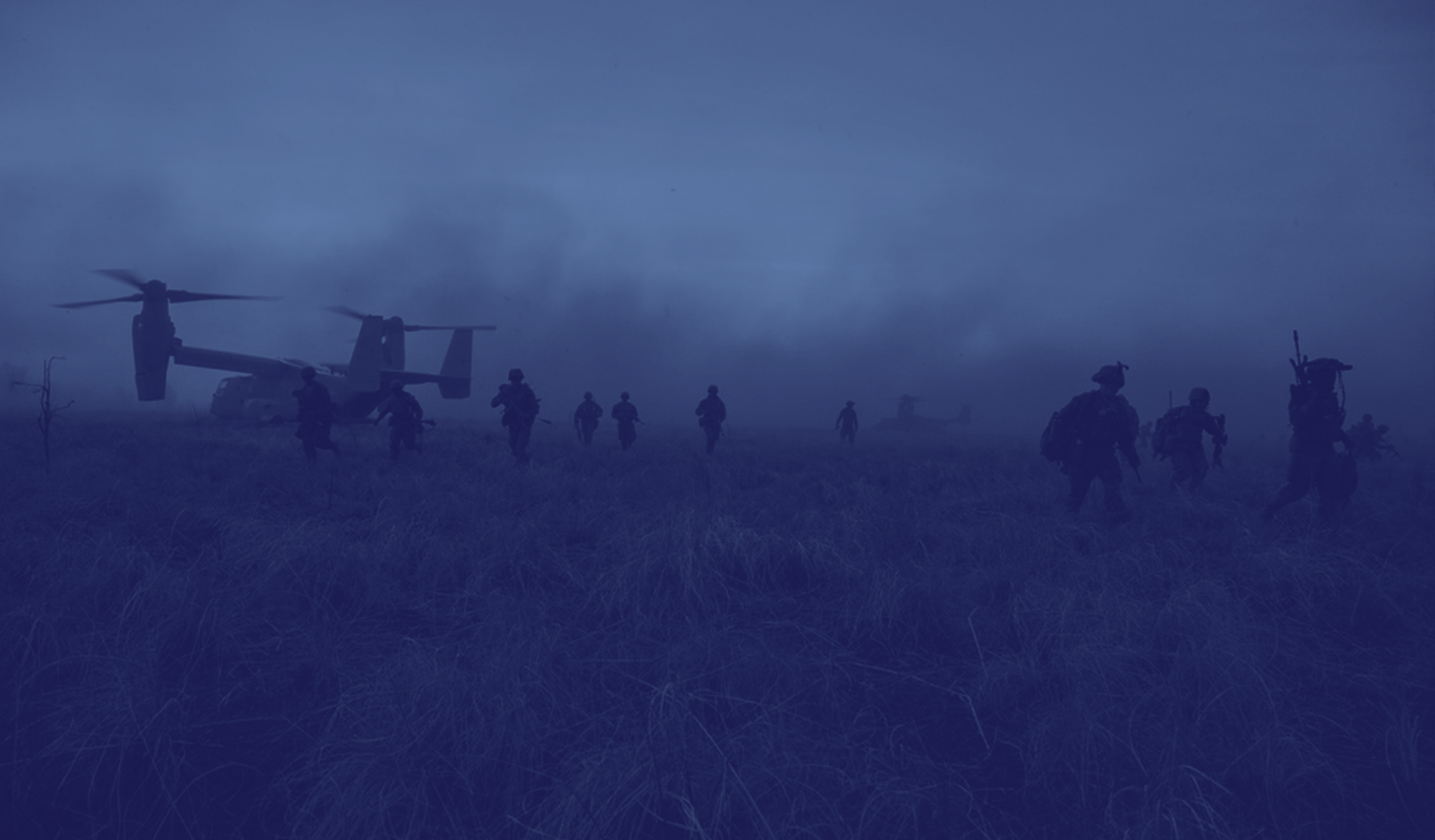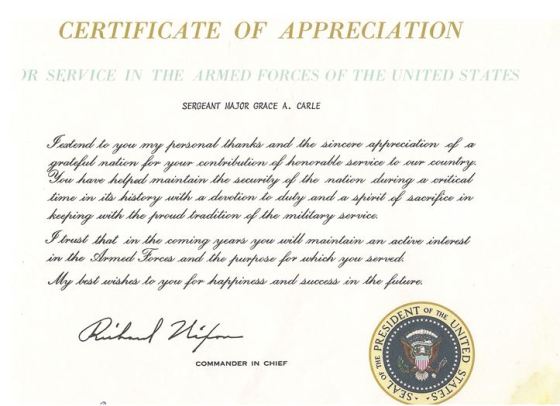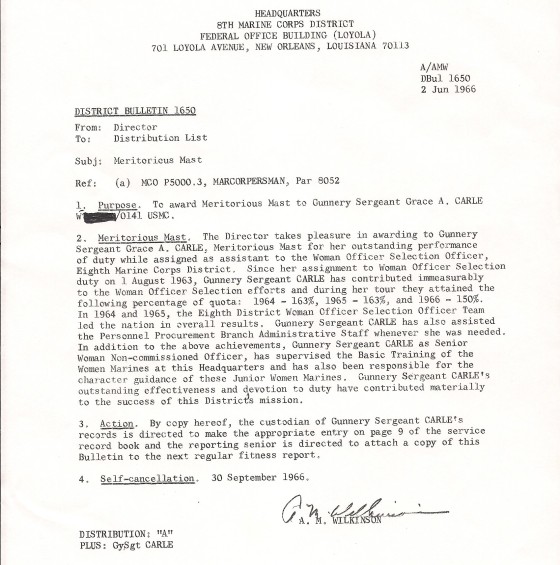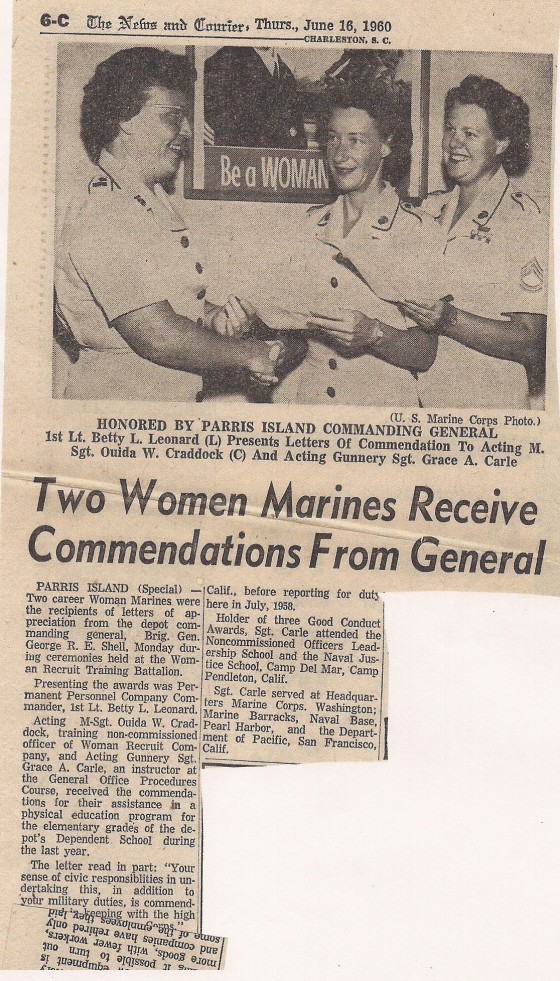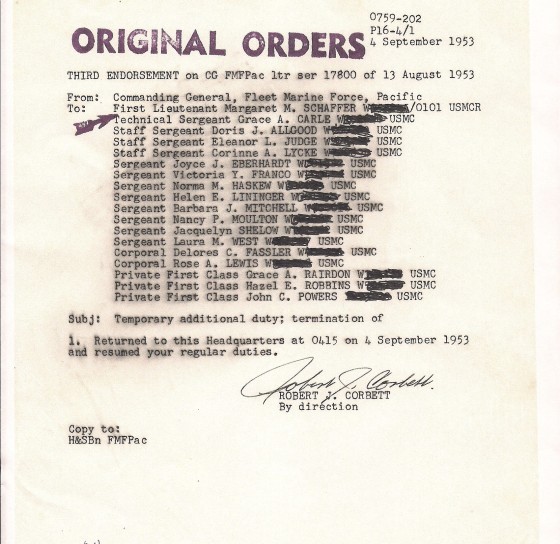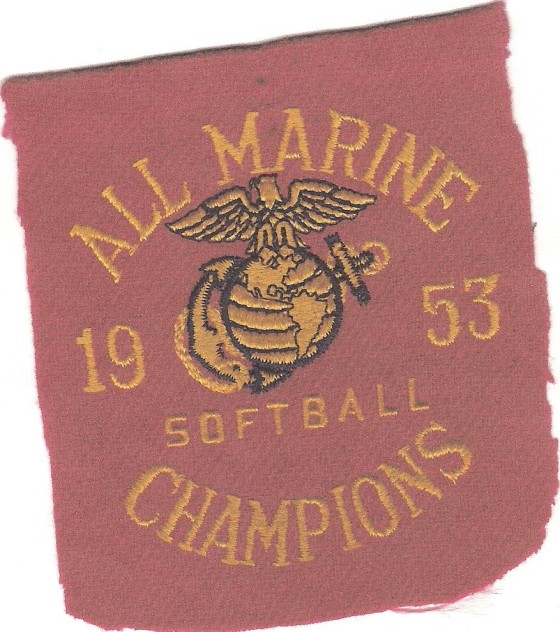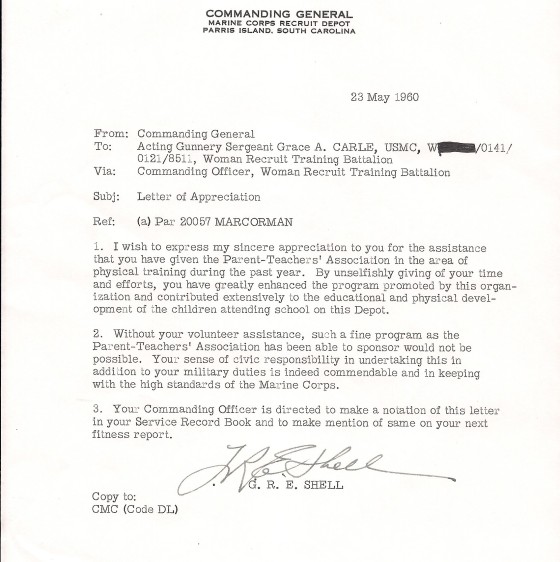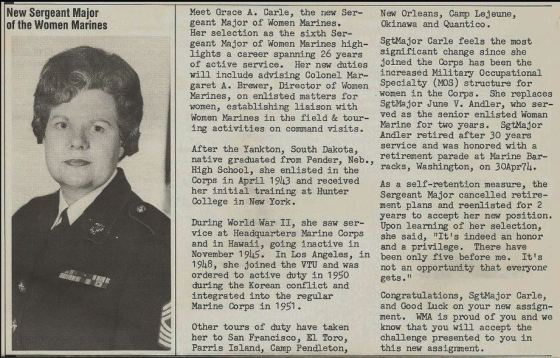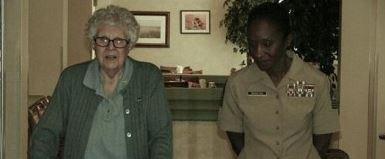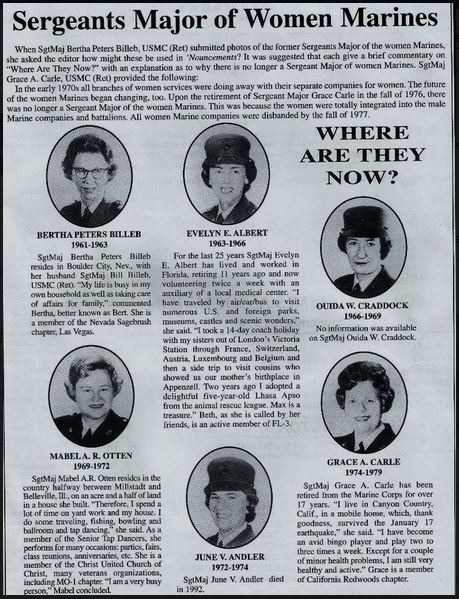Grace Carle
Sergeant Major of the Women Marines
By Sharon Tutt
It became a customary tradition for some women Marines to include in their nightly bedtime routine a chant for a particular hard charging Devil Dog’s name as inspiration. She was the last Sergeant Major of the Women Marines, one of the oldest Women Marine Association lifetime members and a World War II veteran. That could only be, “Grace A. Carle;” which is pronounced Grace Carl.
This writer had the opportunity to have several telephone conversations with her. In those conversations, this salty Marine shared many stories that could parallel most Women Marines military experiences. This writer thinks this is the highest honor bestowed on a Marine when you’re given the opportunity to talk with someone who has lived the history that you have learned, you can identify in your own contributions made to the Corps and understand how to adjust your direction as the Corps direction transforms. As this writer listened to her recount events history books, boot camp styled classroom material and even news articles have chronicled about the Marine’s involvement in this country’s most important battles, it struck this writer odd how matter-of-factly SgtMaj Carle stated that she feels any Woman courageous enough to earn their Eagle, Globe and Anchor would have been acknowledged with the same “winks” and “nods” for a job well done. SgtMaj Carle stated, “We are sisters and have a common bond. We may never have met but we have served and are proud of our service; that’s what it means to me.”
Not deterred by the awestruck manner that this writer soon became when realizing these are the types of stories that should not be lost nor forgotten. How often would any Marine have this opportunity to connect women’s history with this much detail? These are the stories that many people would not have the opportunity to share in a verbal context such as a handwritten journal would reveal. SgtMaj Carle recanted from memory the service that she honorably did for the Corps with the same accuracy chronicled from various newspaper articles that either mentioned her service or highlighted her military contributions.

Sergeant Major Carle shared that she was 20 years old when she enlisted in the Marine Corps. In her time, that was the age requirement and she had to have her parent’s consent. When World War II broke, she had heard about the WACs and she didn’t care to enlist amongst them. She also heard about the WAVEs and she decided that she didn’t like being on the water. When she had heard about the Marines, she decided that is the branch of service that she wanted to enlist. She was born in Yankton, South Dakota on 2 September 1922 and grew up in a small town named Pendor, Nebraska. She was sworn into the Marine Corps Reserves on 23 April 1943 at the Marine Corps Recruiting Station in Des Moines, Iowa. She then received her orders on 13 June 1943 and took a train ride to New York that turned out to be the first time that she had ever rode a train East of Nebraska.
She was met in New York City’s train station by a Lieutenant and Sergeant who escorted her to Hunter College for her three week training. She remembers being quartered with the WAVEs. The Marines lived on one side of the street and the WAVEs were housed on the other side of the street where they took over the civilian apartments. Every morning they would fall out to be inspected and march to class. “The Marines would march a half cadence faster than the WAVES. This would cause the WAVES to wait for us to march through the gate first,” recalls SgtMaj Carle. She also remembers having male DIs fresh out of Parris Island that taught them how to drill. At first, the DIs were not too happy about teaching women how to drill. “They were tolerant of us because they couldn’t use foul language. So when they got mad, they would say ‘Oh, you act like a bunch of girls’”, SgtMaj Carle chuckled as she remembered that fact.
This quick witted Marine understands the important balance that it takes for any Woman Marine when they interact with a Male Marine. She acknowledges that it appears to be one of the most common encounters that Women Marines has shared throughout Women Marine history. She remembers most Male Marines referred to the women of her time as ‘gals’. SgtMaj Carle stated that sometimes the nature of the experience put her in strange territory. In her time, many of the Male Marines that she met were coming back from the battlefield and this was the first time they had seen a Woman Marine. She remembers what changed Male Marines behavior for accepting Women Marines. “It was how we conducted ourselves and it set the tone for how Male Marines treated women. It took Male Marines a while to adjust and I believe we proved to them that we could do the job. I think that I know talking with other Women Marines in my era we worked hard probably twice as hard to prove we should have the name of Marine. Liked it or not we are here. After a while the men learned to accept us,” reflects SgtMaj Carle.
She recalls her group was the last Women Marines to train in the 8th Regiment at Hunter College. According to We Are Marines! World War I to Present: Stories of Women Marines by Women Marines, “Hunter College’s curriculum taught the recruits general subjects about the Marine Corps rules and regulations. The classroom instructors were all officers in the Marine Corps which lent authenticity to what they were learning with words such as “snafu” or “as you were.” SgtMaj Carle recalls the Corps was more focused on getting them through basic training and into the field so more men could be relieved to go fight. She also remembers that she didn’t have uniforms until 3 days before training ended. Once they received their liberty, a group of the women took a bus trip into the Bronx. That was her first time ever being able to explore in depth such a large metropolitan city as New York City. Her graduation date was 3 July 1943. A week later she got orders to go to Headquarters Marine Corps (which ended up being her first duty station and her very last duty station).
When she reported on board at Henderson Hall on 10 July 1943, she was first quartered with the WAVES until the new barracks were completed. A month later, her group was the very first women’s group to move into the new barracks. Every morning she would fall out into formation and march over to the Navy Annex to report for her duty assignment. Her first assignment was working for a general who wrote a lot of books. A month later she was moved down to the Admin Section as a clerk typist. In February 1944, she heard about the War breaking out and decided to put in for orders to go to Hawaii. In order for her to do that, she once again had to get her parent’s consent to travel outside of the Continental U. S. as well as taking a reduction in rank to corporal to fill the available billet in Hawaii. SgtMaj Carle shipped out aboard the Lurline, a luxury cruise ship that was converted to a troop ship in February 1945.
While in Hawaii, she was stationed on a compound that was fenced in because of war time activities. So she cherished the times they would venture out on liberty to trek the half mile down the road to go to watch movies. The group would take a can of spam and crackers as their snack. Since the movies was located near Hunter Field (the Army base), she remembers the group would look at the planes take off at night instead of what movie was being played on the screen. She also recalls it would be early in the morning when the planes would come back. That way they knew the planes may have been going somewhere in the Pacific on missions. There was another time that she can recall, it was her 23rd birthday and she marched down the main street in a parade on the day Japan surrendered to the United States in Hawaii. SgtMaj Carle also earned her sergeant stripes back before she rotated back stateside where she was discharged.
“I got out on 7 November 1945 because the Marine Corps was discharging all Women Marines except 100,” SgtMaj Carle said. According to We Are Marines! World War I to Present: Stories of Women Marines by Women Marines, the Marine Corps wanted to retain a small nucleus of trained women to setup a post-war Reserve to avoid from having to start from scratch. In the Women Marine Association Volume I publication, an all-woman Volunteer Training Unit in Los Angeles, California had been established. In 1948 while living in Los Angeles, California, SgtMaj Carle joined the voluntary training unit that became the nucleus for the Women Recruiting Platoon, 13th Infantry Battalion. SgtMaj Carle was promoted again to the rank of sergeant while on reserve status. In 1950, the Marines mobilized this unit for the Korean conflict and she went back on active duty. She was slated to be stationed in San Francisco, California where she would work in the Mail and File Section of the Department of Pacific. Before reporting to San Francisco, the platoon was ordered to the Navy and Marine Corps armory for two weeks in an active duty status. The unit helped the men pack and get their paperwork in order. In August 1951, SgtMaj Carle integrated into the Regular Marine Corps.
During this time, she can recall her greatest desire was to learn everything that she could. She would constantly seek out the women surrounding her to see how they behaved. She would also determine how this behavior made them successful. So when she set her goals then she would adopt some of those habits and follow in the successful manner as other Women Marines have led. She always believed that if you want to be successful and to become a great leader then you must work hard to achieve that goal. SgtMaj Carle applied this to all areas of her Marine Corps experience. On active duty, SgtMaj Carle was transferred to Hawaii and worked in the Secret and Confidential Files Section (S&C) working for Major Barbara J. Bishop. Major Bishop would later become the Director of Women Marines. Her next duty station was Marine Corps Air Station, El Toro, California where she was again assigned to the S&C File Section. SgtMaj Carle attended Noncommissioned Officers Leadership School at Quantico, VA in February 1955 and Personnel Administration School at Parris Island, SC in September 1955. With this training, she became the Sergeant Major of Women Marines Detachment-1 at El Toro, CA. During May and June of 1956, she was one of three women Marines to attend the first class on the Uniform Code of Military Justice School that was held at Camp DelMar, CA.
SgtMaj Carle also used this ability when she was transferred to Parris Island, SC as an Instructor at Parris Island in 1958. She taught the General Office Procedures Course (a four week course in typing and the filing system). While at Parris Island, Ouida Craddick and SgtMaj Carle received a letter of appreciation from the Commanding General, Parris Island Brigadier General George Shell for assisting in the physical education program for the elementary grades for Depot Dependent School in 1958 on their off-duty time.
SgtMaj Carle used her philosophy of hard work throughout her career as she attained rank. Between 1943 and 1945 she received rank very quickly. This allowed her to pick up Private First Class on the same day that she reported for duty at the Navy Annex, Arlington, Virginia. In 1944 since the lance corporal rank did not exist, she obtained the rank of Corporal on 18 December 1943 and Sergeant on 12 February 1944. SgtMaj Carle was still serving on reserve status in San Francisco when she was promoted to Staff Sergeant on 25 May 1951. On 1 March 1952, she was promoted to Technical Sergeant because that was the next rank during that time. The chevrons were squared and went straight across at the bottom portion not like the curved pattern of today. In December 1960, Technical Sergeant Carle was transferred to Camp Pendleton and assigned the Chief Clerk for H&SBn. On 1 January 1961, she was officially appointed to Gunnery Sergeant. On 1 June 1966, SgtMaj Carle was promoted to Master Sergeant. At Camp LeJeune, she was assigned first sergeant of Women Marine Company, H&SBn, Marine Corps Base, Camp LeJeune, NC. She attended First Sergeant Personnel Administration course at Parris Island, SC during July to September 1968. Upon transferring from Camp LeJeune to Marine Corps Base, Camp Butler, Okinawa Japan, she reverted back to first sergeant to take the assignment as first sergeant of Women Marine Company. While stationed at Camp Butler, she was promoted to Master Gunnery Sergeant on 1 March 1970. SgtMaj Carle transferred to Quantico, VA in May 1970 and was assigned to the Woman Officer School as the S-3 Operation Chief. Upon the retirement of Sergeant Major Phyllis McCuine, she was assigned Sergeant Major of WOS, the position she held at the time of her selection as Sergeant Major of Women Marines.
This philosophy also encompassed SgtMaj Carle’s determined will to succeed in all her endeavors. This showed when she played softball and basketball at HQMC and her tours of duty in Hawaii (both during WWI and also in 1953). “We beat the West Coast Champs, a team from El Toro, CA and then we beat the East Coast Champs, a team from Parris Island, SC.” According to SgtMaj Carle, this feat allowed her team to become the first All Marine Corps Softball Champions for Hawaii in 1953. SgtMaj Carle also obtained a Certificate of Appreciation from President Richard Nixon, the American Area Campaign Medal, World War II Victory medal, Asiatic-Pacific Area medal, National Defense Service Medal with one star, Good Conduct medal with 2 Bronze Stars and one Silver Star (which was an accumulation of nine awards), the Navy Achievement Medal, Letter of Appreciation from the CG, MCRD, Parris Island, SC, Certificate of Recruiting Excellence by the CO, 8th MCD, New Orleans, LA, Meritorious Mast and a Meritorious Unit Commendation at the Women Officers School, Quantico, VA.
SgtMaj Carle’s desire to learn everything that she could as she accepted her Marine Corps assignments attributed to her achieving exemplary success with each goal. In June 1963, GySgt Carle was transferred to Parris Island, SC to attend Recruiters School. When GySgt Carle completed Recruiting School in July 1963, she was assigned as the assistant on Woman Officer Selection Duty to the 8th District, in New Orleans, Louisiana. SgtMaj Carle received a Meritorious Mast because 1stLt JoAnn Canal, officer in charge, along with herself exceeded their quota for three consecutive years. They consistently recruited more females to join the Marine Corps as officers from 5 states; New Mexico, Louisiana, Oklahoma, Arkansas, and Texas. The Meritorious Mast read in part, “Since Gunnery Sergeant Gracie A. Carle has contributed immeasurable to the Women Officer Selection efforts and during her tour they attained the following percentage of quota: 1964 at 163%; 1965 at 163%; and 1966 at 150%. In 1964 and 1965, the Eighth District Women Officer Selection officer Team led the nation in overall results.” In 1966, she got orders to Camp Butler, Okinawa while in Camp Lejeune in 1969, the billet required a Master Sergeant for the assignment. When she got to Camp Butler, she got the chance to be temporarily appointed to First Sergeant. When she received orders to leave Okinawa, Japan, Colonel Jeanette Sustad, Director of the Women Marines personally delivered her promotion certificate and Brigadier General Robert Barrows (who later became Commandant of the Marine Corps), who was in command of Camp Butler, promoted her. She was appointed Master Gunnery Sergeant when she left Okinawa, Japan. She heard about Sergeant Major Phyllis McCuine in the Women Officers School (WOS) at Quantico, Virginia was retiring in1970.
In her role as a Sergeant Major, she had a desire if she could touch one life then she felt she had did her job. Well she recalls a time where this wish was accomplished when she was at the Women Officers School in Quantico, VA. As described by the then Colonel Carol A. Mutter, “SgtMaj Gracie Carle was then a 1stSgt when I was running platoons through OCS (Officer Candidate School) and Basic (The Basic School) in 1971 to 1973; a sixteen hour a day job. As a 1stSgt, she was terrific.” LtGen (Retired) Mutter went on to say, “She was certainly very professional and always trying to ensure the enlisted women in the unit minded their Ps and Qs”. While at WOS in Quantico, SgtMaj Carle remembers when she was on the board to help women officer candidates get evaluated to become commissioned Marine Officers. Every six weeks all the candidates and their file cases and other records came before the board with their platoon leader’s recommendation. The Board would make a recommendation on the candidate to continue in school. She remembers one case in particular – she was part of a five women committee. They would go around and vote to decide to recommend whether the candidate should continue training or to be dropped from training.
SgtMaj Carle had the deciding vote and saw that this particular candidate really had what it took to be a Marine. SgtMaj Carle remembers telling the board, “There is something about this young lady. I don’t know what it is but I have a feeling if we give her a chance she will succeed.” Normally, the selection process was never discussed beyond those doors but this one particular Marine found a way to find out who had saved her Marine Corps career. One day a Major approached her. SgtMaj Carle remembers the major saying to her, “SgtMaj if it wasn’t for you I wouldn’t be here today.” The then major retired as a full bird colonel and she still keeps in contact with SgtMaj Carle to this day.
There was another time that simple goal made her heart fill with pride. It was when she was a First Sergeant at Camp Lejeune, she remembers counseling a particular lance corporal about straightening out her career or else she would go down the toilet. She remembers the lance corporal had listened to her sound advice as well as not having any other problems while she was stationed at Camp LeJeune. Several years later, SgtMaj Carle got to meet the fellow Marine again and to her surprise this Marine let her know that if it wasn’t for her she wouldn’t have made it to SgtMaj.
In 1976 at Henderson Hall she was named the SgtMajor of the Women Marines. She had put in her retirement papers and heard that June V. Andler, the present SgtMajor of the Women Marines was retiring. The Marine Corps was going to have a board meeting to decide the next SgtMajor of the Women Marines. Her colonel sat down with her and for four hours they went over the pros and cons of becoming the SgtMajor of the Women Marines. So it was decided to put the call into Col Brewer to put her name in the hat. SgtMajor Carle’s only wish to her colonel was not to tell a soul on Quantico. In that manner, if she wasn’t selected then no one will know she was up for the position. When the call came down from the Commanding General at Quantico, SgtMajor Carle sounded off when she answered the telephone. He congratulated her and she hung up the phone. There were a couple of Marines who were snickering at her from the doorway after she hung up the phone call. She asked “What?” They told her that she was standing at attention. She replied to them, “Well, I was talking to a General, wasn’t I?”
She had no idea that she would end up being the SgtMajor of the Women Marines. She worked with the then Colonel Margaret Brewer, Director of Women Marines. She remembers that she was a wonderful lady who took it to heart to find ways of making sure that Women Marines’ presence in the Corps was there to stay. Her job was to travel with Col. Brewer to different bases talking to Women Marines. Another part of her job as a Sergeant Major that she enjoyed was being a part of the discussions that advised the Marine Corps about their thinking on what women could and could not do.
In 1976 SgtMaj Carle heard about the discussion of integrating male and female Marines together. She officially decided to retire on 31 October 1976 and was transferred to the Fleet Reserves. She had her retirement parade at 8th and I and was awarded the Navy Achievement Medal for playing a role in shaping how Women Marines would seamlessly integrate without any incident with Male Marines. SgtMaj June V. Andler and she were the only Women Marines to have such a distinction of a parade at 8th and I. SgtMaj Carle most memorable Marine Corps moment was her retirement dinner. The Women Marine Association Volume 1 explains how the Marine Corps held a mess night for SgtMaj. Carle at the Sheraton Hotel on 29 October 1976. It was an occasion attended by Women Marine officers and enlisted from all East Coast posts. “I felt a special tug in my heart to be included in an old Marine Corps tradition – mess night — where the most senior male sergeant at the affair would cut the meat,” SgtMaj Carle stated.
In June 1977, the Marine Corps officially integrated the Women and Male Marines. Since her retirement, Graci moved to Bremerton, WA for a year. She decided to become more active and wanted to contribute her services to military association and then moved to Oakland, CA where she continued to see the similarities of how the Marine Corps’ mission continues to change for women today. According to the Leatherneck 26 August 2004 posting, then retired SgtMaj Carle stated, “I am very impressed with the Marines of today…They really look sharp and I am proud of them. I hope they continue to serve our Corps honorably.” While in Oakland, CA she became President of the Redwood Chapter (CA-9), from February 1987 to February 1990. She is also a lifetime member of the Women Marine Association (Number 174) and continues to notice how things have changed back in WWII when the Corps officially introduced Women Marines in the Reserves to fill desk jobs that Male Marines were doing to the present day times where Women Marines are now being accepted into combat roles.
“I like to think that I have the distinction of being ‘LAST’. I was in the 8th and last Regiment that trained at Hunter College, New York. I was the second and ‘LAST’ SgtMaj of Women Marines to have their retirement parade at Marine Barracks, 8th and I. My first and ‘LAST’ duty stations were at Headquarters Marine Corps, Washington, DC. I was the sixth and ‘LAST’ SgtMaj of Women Marines”, concluded SgtMaj Carle. She currently resides in Monte Vista Village, a Senior Retirement community, where she leads the veteran’s group and also allows her to be closer to family members.
References:
- Ellie, Marine Corps Recruit Depot San Diego, Calif.September 10, 2004
- Lacy, Linda Cates (2004). We Are Marines! World War I to Present: Stories of Women Marines by Women Marines Women Marines Association. pp. 26, 40, 43,44, 120. December 21, 2008.
- Stremlow, Colonel Mary V., USMCR (Ret) (1994). Free a Marine to Fight: Women Marines in World War II. Marines in World War II Commemorative Series. Washington, D.C.: Marine Corps Historical Center, United States Marine Corps. Retrieved December 21, 2008.
- The Free Lance Star, April 27, 1074, Sgt.Maj. Carle: Sergeant Major reaches ‘ultimate’
